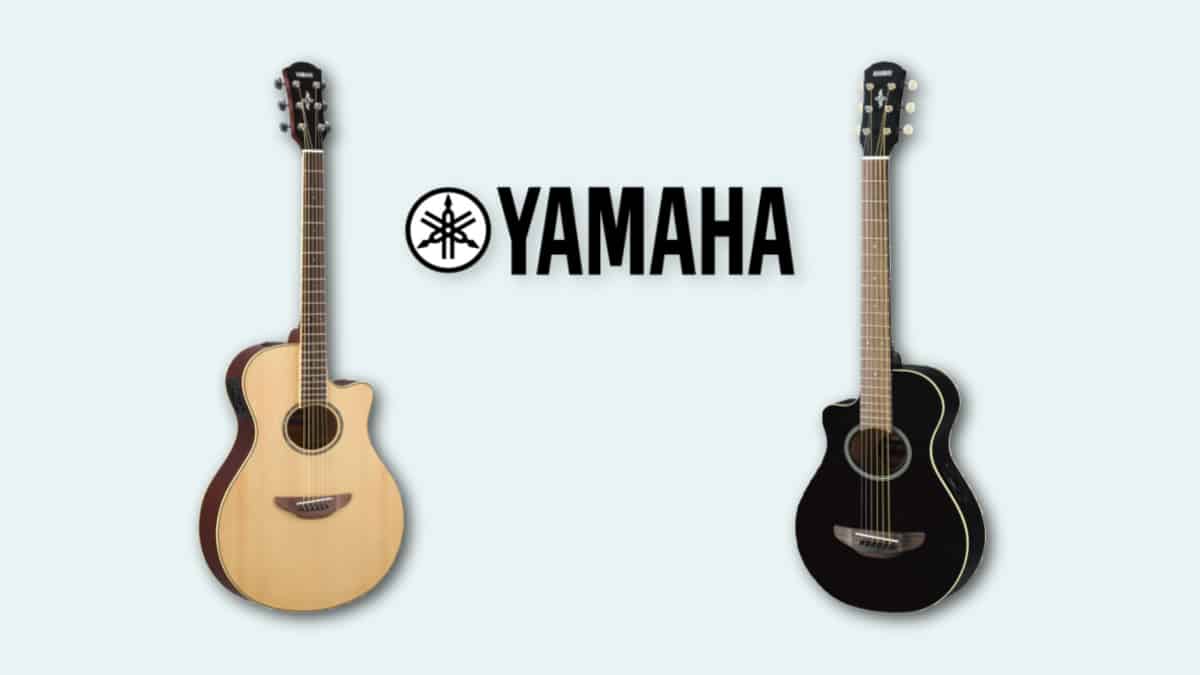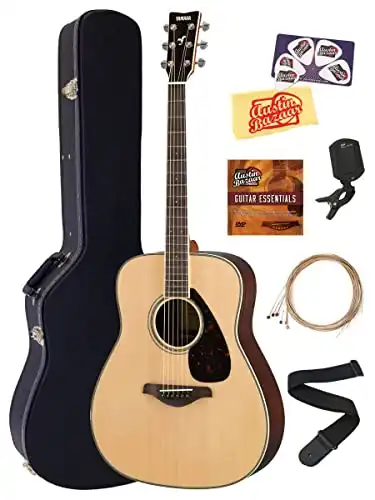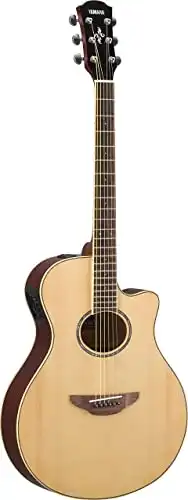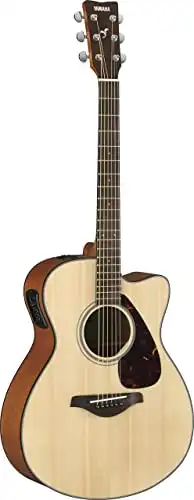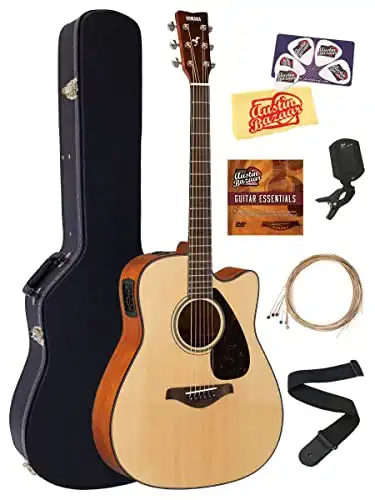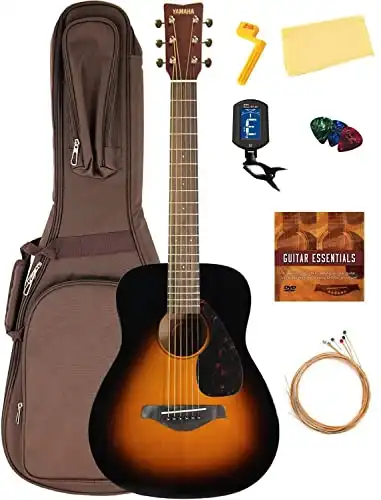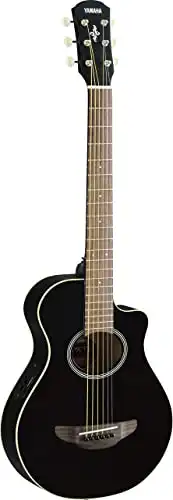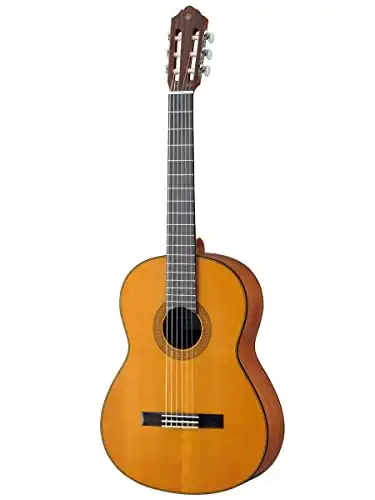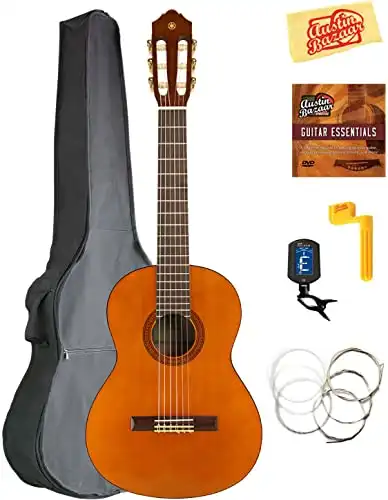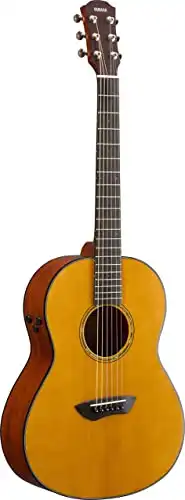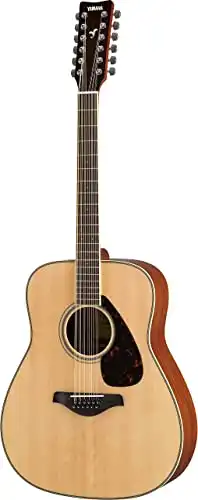Wanna cut to the chase? I went looking for the best Yamaha acoustic guitar, and my top pick is the Yamaha FG830 Folk Acoustic Guitar.
To make life easier for you, I wrote several organized and in-depth Yamaha acoustic guitar reviews (including lists of pros & cons that you can quickly scan).
I tested out several of these guitars in real life (the ones I could find). I also carefully researched what other people were saying about them online.
The Yamaha guitar that’s best for you will depend on your budget, skill level, hand size, and more.
Let’s explore each of those factors to find your best fit. Then we’ll get into individual reviews.
Why Bother Reviewing Yamaha Guitars?
Yamaha’s been making guitars since 1942. They make a ton of different models, and they have an overall good reputation.
Yamaha acoustic guitars tend to be in the lower or middle price range, which makes them affordable entry-level options.
Because they make so many guitar models, you’ll have plenty of options to choose from.
It also helps that most of their lower-priced guitars come with “starter packs” that have all the extra stuff you’d need to get started (like a tuner, case, picks, etc).
Are Yamaha Acoustic Guitars Any Good?
Based on the ones I’ve tried, I don’t think Yamaha guitars are the best of the best, but they tend to sound pretty good and be decent quality.
The prices are reasonable as well, so you’ll probably get a good value for your money, which makes them a good option for beginners or anyone on a budget.
How To Find The Best Yamaha Acoustic Guitar For Your Needs
To find a good Yamaha acoustic guitar that fits your personal needs and preferences, there are a few things to pay attention to.
Steel-string acoustic vs. Nylon-string classical guitar
Yamaha is more known for their standard acoustic guitars with steel strings, but they do make some classical guitars with nylon strings as well.
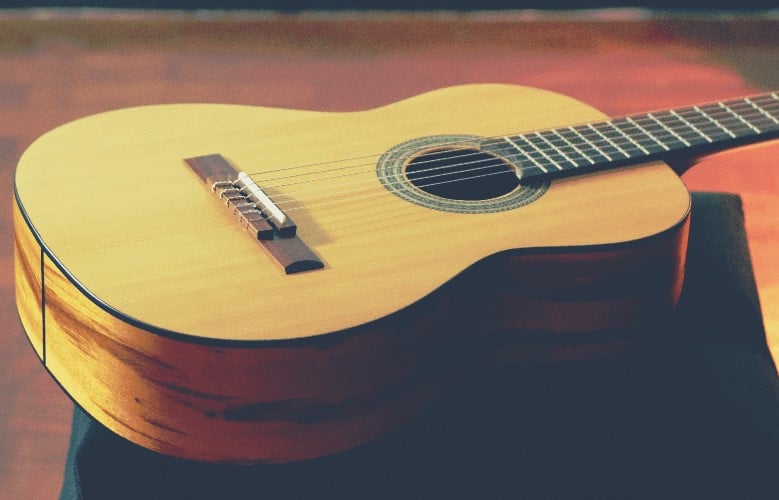
Steel strings have a brighter, edgier sound, and nylon strings have a softer, mellower sound.
Steel strings are also more typical for certain styles of guitar music, such as the Blues.
While I slightly prefer the sound of steel strings, the main guitar I use at home is a classical guitar with nylon strings.
It’s worth it to me because the nylon strings don’t hurt my fingers as much, and they’re easier to play in general.
Using nylon strings is a little bit like playing electric guitar strings, because they’re easy to push down. But nylon strings are also wider and softer than steel strings, which makes them even more comfortable for your fingers.
If I were looking for the best Yamaha acoustic guitar for beginners, I would definitely consider one with nylon strings simply because it’s easier (and less painful) to play.
I included a couple Yamaha classical guitar reviews in this article (one for adults and one for kids), in case that’s something you’re interested in.
Yamaha Guitar “Action”
Action on a guitar refers to the space between the strings and the fretboard, or in other words how far you have to push the strings down to make a note.
Low action means a short distance, high action means a longer distance.
Basically, the lower the action on the guitar, the easier it will be to play.
While Yamaha guitars are typically a good value for the money, one weakness is that some of them have high action right after purchase, which can make them harder to play.
However, you can have the action adjusted at a guitar shop (usually for a little under $100), so it doesn’t have to be a deal-breaker.
If you do have a guitar with high action, it can tire you out and you won’t be able to play for as long in one sitting.
It’s also more uncomfortable for the tips of the fingers on your left hand (assuming you’re right-handed).
This happened to me when I first started learning – I borrowed a guitar from my friend that had pretty high action, and my left wrist and forearm would get tired out if I played too long.
Pay attention to what reviewers say about the action on Yamaha guitars, and keep in mind you could end up needing to have it adjusted if the action is too high.
Regular acoustic vs. acoustic-electric
If you think you’ll be jamming with other instruments (like drums or electric bass), or performing in front of any large crowds, you should strongly consider getting an acoustic-electric guitar.
That way you can easily connect to an amp or a PA system.
Many times in the past, I’ve had to hold my acoustic guitar stationary in front of a microphone so it would be loud enough during a performance. Whenever this happened, I always wished I had an acoustic-electric guitar instead so I could just plug it in.
I included a few Yamaha acoustic-electric guitar reviews on this list, so hopefully you can avoid running into the same problem.
Sound quality
Most Yamaha guitars have at least decent sound quality, but even the best Yamaha acoustic guitar models may not sound as good as higher-end brands (like Taylor, Martin, or Gibson, for example).
I’ve noticed that the smaller Yamaha guitars (like travel or ¾ size) can have a somewhat hollow or empty sound compared to larger ones.
Body Size
Yamaha guitars range from quite small (like the 3/4 size) to pretty big (like the dreadnought, which is historically the most common guitar design), and beyond.
As mentioned above, larger guitars typically have a louder and more resonant sound.
Perhaps more importantly, the size of the guitar should roughly correspond to the size of the person playing the guitar (and the size of that person’s hands).
If you have small hands, it may be awkward or difficult to play a large guitar. The opposite is also true–someone with large hands may have a hard time playing a small guitar.
I included Yamaha guitars with various sizes in this article in case you’re looking for the best small acoustic guitar or the best intermediate / mid-range acoustic guitar, and so on.
Body shape
Yamaha guitars come in various designs (like dreadnought, concert, and parlor). These names refer both to the guitar size (dreadnought is bigger than concert which is bigger than parlor), as well as the particular shape of the guitar.
As mentioned above, keep in mind the size of your hands when picking a guitar design.
Another thing to consider is getting a “cutaway” (where it looks like a bottom corner is missing). This makes it a lot easier to play certain notes and chords on the higher frets.
Having a cutaway can be helpful for some styles of music that involve a lot of soloing or unusual hand movements, like blues or fingerstyle.
Not only can you reach notes more easily, but you’ll be less likely to need hand therapy without all the strain on your wrist and fingers. 🙂
On a personal note, I’ve actually never owned a cutaway guitar. But every time I play one I’m reminded how much easier it is to reach the high frets. I plan to get a cutaway next time I buy a guitar.
Type of wood
Bottom line: Don’t worry about the type of wood unless you’re a very advanced player looking for a specific sound (and you can skip the next two paragraphs if you want).
In case you’re curious, common wood types include spruce (which has a more crisp and punchy sound), cedar, and mahogany (both said to have a warmer, softer tone), among others.
Another difference is whether the guitar is made from solid wood (which vibrates freely, providing a more sustained sound), versus wood laminate (which is more stiff, making it less resonant but also strong and durable, as well as less expensive than solid wood construction).
Guitar accessories
If you don’t already have a guitar tuner, capo, picks, or other accessories, you can probably find a Yamaha “starter bundle” that includes all of these along with the guitar.
Some of the guitars I reviewed come with starter bundles, so keep an eye out for that.
[REVIEWS] Best Yamaha Acoustic Guitars
Now that you know what to look for, let’s go over some specifics to help you find the best option for your needs.
Top Pick: Yamaha FG830 Folk Acoustic Guitar (+ starter bundle)
This is a moderately priced guitar that gets rave reviews from most purchasers.
The sound quality is excellent due to the large body, solid wood top, and “scalloped” internal bracing (an unusual feature).
It comes with all the accessories you need (including a hard case, which is not typical), so you probably won’t need to buy anything else.
While it doesn’t have an electric pickup, it’s loud enough on its own for most situations (other than performing in a large venue or jamming with really loud instruments).
It lacks a cutaway shape, so it will be harder to reach some of the higher frets.
The action varies and can be high or low depending on the individual guitar, but it’s fairly easy to have this adjusted at a guitar shop (for about $80 on average), if necessary.
Because it provides great value for the money and gets consistently excellent reviews, this is my top pick for the best Yamaha acoustic guitar.
What I Like
- Incredible sound
- High-quality starter pack
- Hard case
- Big and loud
What I Don’t Like
- Action may be high (but can be adjusted)
- No cutaway
- Not acoustic-electric
Yamaha APX600 Thin Body Acoustic-Electric Guitar
This guitar is moderately priced, has an excellent sound, and has the advantage of being both an acoustic-electric and a cutaway.
When I tried it out, I found it easy to play and thought it sounded great.
It’s somewhat on the smaller end, but not tiny.
The action on mine was medium, but this can vary from one guitar to the next and may need to be adjusted at a guitar shop.
It may not be the best yamaha acoustic guitar ever made, but this is a solid option with several attractive features and a reasonable price.
What I Like
- Acoustic-Electric
- Cutaway
- Nice sound
- Fair price
- Pleasant size (at least for me)
What I Don’t Like
- Action varies (may need adjustment)
- No accessories
Top Acoustic-Electric: Yamaha FSX800C Small Body Acoustic-Electric Guitar
This is a reasonably priced acoustic-electric guitar with great sound quality.
It’s a medium-sized concert style, which makes it comfortable to hold and play for most people.
It’s not quite as loud as a larger guitar would be, but it has a pickup and preamp so you can easily plug it in to an amp or a PA system if you need more volume.
It’s also a cutaway, so it’s easier to reach the higher notes.
The only significant downside I’m aware of is that the default action on this guitar varies a bit, so it can be high or low. Luckily, you can have this adjusted, so I don’t think it’s a deal-breaker.
Because this guitar has an almost ideal combination of features at a very reasonable price, this may be the best yamaha acoustic-electric guitar available for the money.
That’s why this is my pick for the top Yamaha acoustic-electric guitar.
What I Like
- Great Sound
- Reasonable price
- Cutaway
- Acoustic-Electric
- Built-in tuner
- Medium size (comfortable for most players)
What I Don’t Like
- Action varies (may need adjustment)
- No accessories (addons may be available)
Yamaha FGX800C Folk Acoustic-Electric Guitar (+ starter bundle)
This guitar is very similar to the other FGX800C listed above, with two main differences.
First, it’s bigger, which makes it louder, but maybe also a little bit less comfortable to hold.
Second, it comes with a robust starter pack, including a hard case and all the other accessories you would need.
Like the above model, it has an electric pickup and built-in tuner.
It’s also a cutaway shape, which makes it easy to reach the high notes.
What I Like
- Excellent sound
- Reasonable price
- Acoustic-Electric
- Cutaway
- Includes a starter bundle
What I Don’t Like
- Action varies (may need adjustment)
- Large size could feel awkward to hold
Top Kids: R2 Junior-Size 33-Inch Acoustic Guitar (+ starter bundle)
This is a “junior” guitar designed for kids, so it’s pretty small.
I tried it out and thought it sounded pretty good (despite its smaller size) and also felt comfortable to play.
The action was low, and the strings were easy to push down (which is important for kids who may have smaller or weaker hands).
It doesn’t have a cutaway shape, so some higher frets are harder to reach.
It’s not an acoustic-electric, so you can’t plug it in to an amp.
The price is very reasonable, and it comes with high-quality accessories so you’ll have everything you need to get started.
This is a great value for the price, and my pick for the best Yamaha acoustic guitar for kids.
What I Like
- Affordable
- Good sound for its size
- Low action – easy to play
- High-quality starter pack
- Light and easy to carry
What I Don’t Like
- Not acoustic-electric
- Not a cutaway
Yamaha APXT2 3/4-Size Acoustic-Electric Guitar
The Yamaha APXT2 3/4-Size Acoustic-Electric Guitar has a unique and attractive body shape and comes in several different finishes and colors so you can pick a style that best suits you. Personally, I love the versatility of this acoustic-electric guitar, and the built-in tuner and cutaway make it extra convenient.
This guitar is about the same size as the “junior” guitar above (they’re both ¾ size), but when I compared the two I noticed this one is a little bit thinner front-to-back.
That may be why the sound was a little more hollow, and sort of “tinny” by comparison.
The action felt fairly low, so the strings were pretty easy to push down.
It’s a cutaway, which is nice for playing higher notes, and also an acoustic-electric so you can plug it in for a jam session or performance.
If you’re looking for a small, reasonably priced guitar with those features, then this is a good option.
What I Like
- Inexpensive
- Acoustic-Electric
- Cutaway
- Small and easy to carry
What I Don’t Like
- Somewhat hollow sound
- Not ideal for large hands
The Yamaha APXT2 3/4-Size Acoustic-Electric Guitar has a unique and attractive body shape and comes in several different finishes and colors so you can pick a style that best suits you. Personally, I love the versatility of this acoustic-electric guitar, and the built-in tuner and cutaway make it extra convenient.
Top Classical: Yamaha CG122MCH Solid Cedar Top Classical Guitar
This is a low to moderately priced classical acoustic guitar with nylon strings.
It advertises low action, and most reviewers agree. Combine this with the nylon strings, and this guitar will be particularly easy to play.
It has excellent sound and a nice-looking finish.
Similar to my own classical guitar, it has a somewhat wide neck. (Wide necks are typical of classical guitars, but can make it harder to reach certain positions if you have very small hands).
If you don’t care too much about not having a cutaway or acoustic-electric plug-in, this may be the best Yamaha classical guitar for the money.
What I Like
- Nylon strings
- Low action – easy to play
- Great sound
- Nice-looking
- Reasonable price
What I Don’t Like
- Not a cutaway
- Not acoustic electric
- No accessories included
Yamaha CGS102A 1/2-Size Classical Guitar Bundle
This is a half-size children’s starter guitar that is very affordable.
It’s also a classical guitar with nylon strings, which make it easy to play compared to a steel string acoustic, and that’s what you want for kids.
It comes with all the basic accessories and an instructional DVD, so you don’t necessarily need to buy anything else (though the soft case may be too loose).
If you want a nice starter classical guitar for a child, this looks like a good option for you.
What I Like
- Good price
- Easy to play (nylon strings)
- Includes a starter pack
- Nice size for a young kid
What I Don’t Like
- No cutaway
- No pickup
- Gig bag may be too loose
Top Upgrade: Yamaha CSF-TA Parlor Transacoustic Guitar
I really liked the look and feel of this guitar, and it sounded great (it has a “transacoustic” internal vibrator to help sustain the sound).
It’s on the smaller side (parlor size), but not tiny like the 3/4 options above. So it’s a good fit for most adults (as long as they don’t have giant hands).
The action was low and easy to play.
It’s an acoustic-electric so you can plug into an amp, but it doesn’t have a cutaway shape so it’s a little harder to reach some of the higher notes.
If you’re looking for an upgrade option and don’t require a cutaway, you would probably like this guitar.
What I Like
- Low action – easy to play
- Medium size – easy to hold and carry
- Incredible sound
- Acoustic-Electric
What I Don’t Like
- Higher price
- Not a cutaway
- Not ideal for huge hands
Yamaha FG820 12-String Solid Top Acoustic Guitar
This is a moderately-priced 12-string acoustic guitar that seems like a very good value for the money.
It has a really nice and bright sound, and plenty of volume.
A lot of people find the action low and comfortable, but others feel it is too high (and end up getting the guitar adjusted, which typically costs a little under $100).
This may be the best 12-string Yamaha acoustic guitar for the money if you don’t need an electric pickup, cutaway, or accessory bundle.
What I Like
- Rich, 12-string sound
- Big and loud
- Fair price
What I Don’t Like
- Action varies (may need adjustment)
- No cutaway
- Not acoustic-electric
- No accessories
Recap and Final Thoughts
While Yamaha acoustic guitars are not the best of the best, they’re a good value for the money, which makes them a solid starter option for beginners or someone on a budget.
Because Yamaha makes a lot of different models, you’ll have plenty of options to choose from, and if you buy a “starter pack” they’ll include any accessories you may need as well.
As a general rule, pick a guitar size that fits your body and hand size.
Most Yamaha acoustics have at least decent sound quality, but very small body sizes can sound kind of hollow or empty.
Consider getting a guitar with nylon strings and/or low action, especially if it’s for a beginner or a child.
Always consider getting a cutaway, as it will be a lot easier to play some higher notes and chords.
It’s also very helpful to have an acoustic-electric if you ever need to plug into an amp or a PA system for a jam session or performance.
Taking all of this into consideration, my top overall pick for the best Yamaha acoustic guitar is the Yamaha FG830 Folk Acoustic Guitar because it’s a great value for the price, has amazing sound quality, and includes a starter bundle to boot.
Regardless of which guitar you get, I hope you have fun with your new Yamaha acoustic guitar, and keep improving your skills.
Thanks for visiting!

